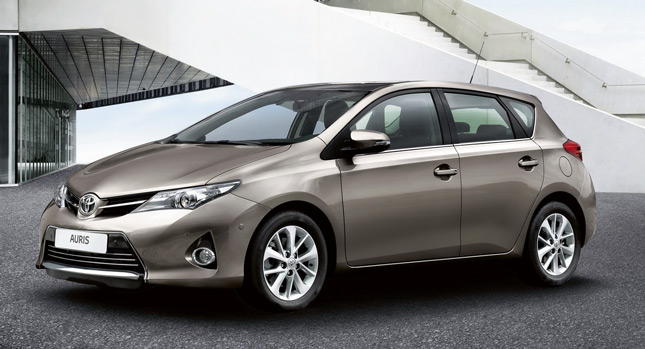About month ago, Toyota unveiled its brand-new 2013 MY Auris ahead of its Paris Auto Show world premiere on September 27.
Now, Japan’s biggest carmaker has shed more light on the latest iteration of what it claims to be the most popular C-segment model series (including the Corolla nameplate) in the world, having sold 39 million units in more than 140 countries since the introduction of the Corolla in 1966.
Toyota says that the second generation of the Auris was specifically designed for Europe, which will be its biggest market. It will be manufactured alongside the Avensis in Toyota’s UK plant in Burnaston, which this year celebrates its 20th anniversary.
Having already released the basic info about its new compact hatchback, today Toyota provided us with more details.
In the European market, the 2013 Auris will be available with five powerplants: two petrol units with a displacement of 1.33 and 1.6 liters, two diesels in 1.4-liter and 2.0-liter displacements, and of course the hybrid version.
All engines have been engineered to be as eco-friendly as possible: the range of the first generation Auris, in 2007, emitted a CO2 average of 152 g/km. This was reduced to 142 g/km in 2009 and with the introduction of the hybrid version, 125 g/km in 2011.
According to Toyota, the all-new Auris will emit an average of just 109 g of CO2 per km, which equals to a reduction of 13 percent compared to the outgoing model.
The 1.33 petrol engine features dual variable valve timing, a high compression ratio of 11:5 and auto stop/start. Its output is 98 HP (99 PS, 73 Kw) and its maximum torque 128 Nm (94.4 lb-ft) at 3,800 rpm. Its average fuel consumption is 5.4 lt/100 km (52.3 mpg UK, 43.5 mpg US) with CO2 emissions of 125 g/km, a reduction of 0.4 lt/100 km and 11 g/km respectively compared to the model it replaces.
Further developing its Dual VVT-i system, Toyota has created the Valvematic, which apart from the timing also controls the lift and duration control of the inlet valve. The Valvematic is fitted to the 1.6-liter petrol engine, which also features a variable-length inlet manifold, further maximizing the engine’s operation.
The 1.6-liter develops 130 HP (132 PS, 97 Kw) and 160 Nm (118 lb-ft) of torque. It is available with either a six-speed manual or a MultiDrive S CVT gearbox with both an auto and a manual, seven-speed Sport mode. The manual version consumes 5.9 lt/100 km (47.9 mpg UK, 39.9 mpg US) on average and emits 138 g of CO2 per km, while the MultiDrive S drops those figures to 5.7 lt/100 km (49.5 mpg UK, 41.3 mpg US) and 134 g/km.
Toyota’s Optimal Drive technology has also been applied to its diesel units. The 1.4-liter D-4D features a two-step hydraulic control valve in the timing chain cover, reducing friction, a new coolant by-pass system that helps reduce heat losses during start-up, and a new generation of piezoelectric injectors as well as a higher common rail pressure of 160 Mpa.
Output is 88 HP (89 PS, 66 Kw) and the maximum torque of 205 Nm (151.2 lb-ft) is available from 1,800 to 2,800 rpm. With the standard six-speed manual transmission and the start/stop system, the 1.4-liter diesel Auris returns a fuel consumption of just 3.8 lt/100 km (74.3 mpg UK, 61.9 mpg US) on the combined cycle and emits 99 g/km of CO2.
 Buyers can also opt for the new MultiMode automated manual transmission that sports two fully automatic gear change modes or a manual, sequential change via the steering-wheel mounted paddles.
Buyers can also opt for the new MultiMode automated manual transmission that sports two fully automatic gear change modes or a manual, sequential change via the steering-wheel mounted paddles.
Featuring a new turbocharger with a lower friction bearing system and auto stop/start as standard, the 2.0-liter D-4D diesel is both lighter and more refined. It delivers 122 HP (124 PS, 91.2 Kw), its average consumption is 4.3 lt/100 km (65.7 mpg UK, 54.7 mpg US), while CO2 emissions have been reduced by 19 percent, from 138 to 112 g/km.
Last, but not least, the full hybrid version of the Auris, which in its previous generation was the second best-selling hybrid in Europe behind the Prius, combines a 1.8-liter petrol engine and a 60 Kw electric motor for a maximum combined output of 134 HP (136 PS, 100 Kw).
Depending on battery charge and driving conditions, the Auris Hybrid can be driven in EV, emissions-free mode for up to 2 km and speeds up to 50 km/h. With the 15-inch wheels, CO2 emissions have dropped below 89 g/km, while performance is more than adequate with a 0-100 km/h (0-62 mph) acceleration time of 10.9 seconds and a top speed of 180 km/h (112 mph).
All versions sport a revised McPherson strut front suspension, while in an unusual move, the 1.33-liter petrol and 1.4-liter diesel will have a torsion-beam rear axle and the 1.6-liter petrol, 2.0-liter diesel and the Hybrid will feature double wishbones. In all models, the reduced center of gravity has allowed the reduction of spring rates and anti-roll bars diameter, resulting in a more comfortable ride, and the electrically-assisted power steering offers better feedback and quicker response to driver’s inputs.
The 2013 Auris will be available in four specifications: Live (entry), Active (mid), Style (sport) and Lounge (high). Toyota expects the Active trim to account for 65 percent of total sales.
By Andrew Tsaousis
PHOTO GALLERY































